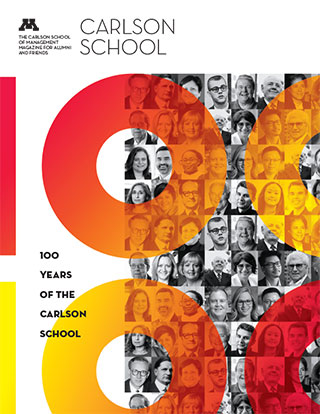
First-Mover Advantage
Monday, October 7, 2019
BY KATE WESTLUND
Today nearly everyone carries a high-powered computer in their pocket, yet not long ago computers were a rare, uncertain, behemoth of technology that few knew how to operate.
The Carlson School of Management was an early adopter and leader in the management of business computing, largely because of Gordon Davis, professor emeritus of Information and Decision Sciences.
Davis came to Minnesota as a management consultant for a paper company in International Falls. His boss offered him a partnership, but Davis wanted to try his hand at teaching. “He thought that [the offer] would keep me in the firm. Actually, [it] caused me to leave. ...I said, ‘Once I make the big bucks, I’ll never be a professor. I better go try it now while I’m poor,’” jokes Davis.
And so at the recommendation of a trusted colleague that he knew from his time as a Stanford MBA and PhD (and already equipped with the knowledge of what a Minnesota winter entailed) Davis joined the University of Minnesota in 1961 as an assistant professor.
The First Computer on Campus
Around the same time, the University gained a UNIVAC Solid-State 80 computer, worth a half-million dollars and weighing several tons. The current dean, Paul Grambsch, asked Davis, an Accounting professor with a plainly stated interest in the burgeoning field of Information Systems (IS), to take the helm. “Nobody knew what to do with it. But it was very much a symbol to the school that we were in the computer age,” says Davis.
The school was able to pioneer this new field thanks to the support of Dean Grambsch and the innovation and excitement of Davis’ colleagues Gary Dickson and Tom Hoffman. “In the mid-1960s, every major business school had one or two faculty members interested in the use of computers,” explains Davis. “But they lacked textbooks, course materials, research support, and a community of like-minded scholars.”
Seeking insights from the local IS community, Davis, Hoffman, Dickson, and Grambsch visited 30 local companies to present their vision for a research center that would inform a new curriculum and contribute to the advancement of the field. Twenty-one businesses signed on as partners, and the Management Information Systems Research Center (MISRC) was born in the summer of 1968. Davis, once again, was asked to lead the new initiative.
Building a Curriculum for New Technology
Shortly thereafter, and applying what they’d learned through the early research of the MISRC, Davis, Dickson, and Hoffman created the Management Information Systems (MIS) curriculum, with 12 graduate-level courses. “[It] was a trial at best,” Davis says of being on the cutting edge. “Not only did we provide the curriculum structure, we were part of every major curriculum study group that was formed during those days.”
Davis and other faculty helped to establish the University of Minnesota as an early leader in what was quickly becoming a global industry.
Davis helped form, and was the fourth president of, a new international faculty organization, the Association for Information Systems. He also served as the U.S. representative to the International Federation for Information Processing (IFIP) from 1982-2001.
Dickson served as the first editor-in-chief of the new MIS Quarterly, which debuted in 1977. In addition to countless scholarly articles and published research, the department produced more than 45 textbooks (including what is perhaps Davis’ seminal work, Management Information Systems: Conceptual Foundations, Structure, and Development), greatly shaping MIS pedagogy.
A Legacy of Leadership in MIS
The Carlson School maintains that high profile. The MIS Quarterly is still printed by the department and is still considered to be a leading academic journal in the field. The MISRC continues to partner with numerous companies on research and other initiatives important to the corporate IS community. And the MIS program has graduated thousands of students who work, teach, and conduct research globally.
During the first year of the program, 10 master’s and eight PhD students enrolled. The focus of the coursework was general computer usage and programming. More than 50 years later, the MIS program (which has grown to include a robust undergraduate curriculum) boasts more than 300 enrollees each year, and those numbers are expected to continue to grow.
Unlike in 1968, today’s incoming students have grown up immersed in technology. Although students still learn the basics, like programming, the curriculum (like the technologies themselves) has greatly expanded.
One such area is in big data. “Our department has been actively involved in starting several new programs in the area of business analytics,” explains Gedas Adomavicius, Carolyn I. Anderson Chair in Business Education Excellence and chair of the Information and Decision Sciences department.
As a result, the Carlson School now offers full-time and part-time masters’ programs in Business Analytics (MSBA), as well as an undergraduate minor in the field, keeping the Carlson School’s course offerings relevant and accessible.
